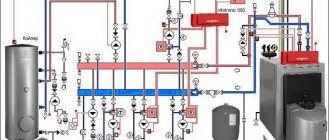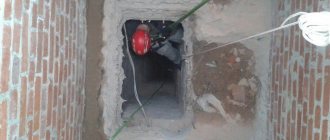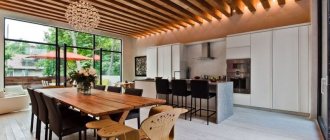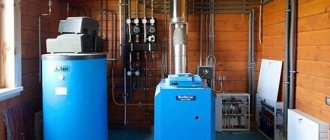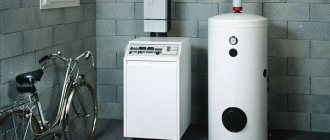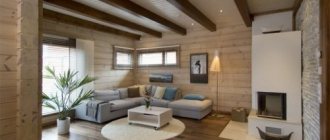Every year the cost of utilities, be it electricity or hot water supply, is growing rapidly. Unfortunately, this is happening both due to the usual inflation and rising energy prices, and because of the banal greed of service providers. That is why today more and more people are looking for an alternative that allows them to reduce fees, which, apparently, will become simply unaffordable in a few years.
Autonomous boiler room in an apartment building
And many people find a solution to this problem. One boiler room per apartment building is able to fully satisfy the needs of all residents, providing them with high-quality heating, as well as supplying the required amount of hot water. However, installing your own autonomous boiler room is an extremely serious decision that cannot be made without thinking everything through and weighing the pros and cons a hundred times. And to do this, you should know both the pros and cons of this solution.
Types and arrangement of roof boiler houses
The standards separately stipulate the possibility of operating a boiler room of built-in and block-modular type. Each type of technical and design solution has its own limitations and features. In general, placing boiler equipment on the roof has several advantages:
- There are no costs for the construction of a separate technical building.
- There is no need to build a high chimney.
- The safety of operating heating equipment increases.
Block-modular roof boiler houses
The following steps are required for installation:
- A platform is installed, supported by load-bearing walls and other building structures. Before installation, an examination is carried out aimed at determining the load-bearing capacity and identifying measures to strengthen the structurally significant elements of the building.
- The covering under the boiler room is made from non-combustible materials. As a rule, a concrete pad with a thickness of 20 cm is poured for this.
- Separate measures are provided to ensure safety (manufacture of railings around the perimeter of the roof) and increase the sound insulation of the modules.
Installation of block-modular heating equipment requires the preparation of a separate project and is suitable for buildings in which it was not initially planned to heat the premises in this way.
A modular boiler house is a fully equipped thermal station, ready for operation. All equipment is built into the module. The BMK is additionally equipped with rooms for service personnel.
Built-in roof boiler rooms
It is much easier to produce and approve a project for a built-in boiler room. Soundproofing, noise-absorbing and anti-vibration measures are carried out simultaneously with the construction of walls and finishing work, which significantly increases their effectiveness. In fact, built-in boiler rooms are provided extremely rarely, mainly in new houses, the construction of which began in the last 5 years.
Rooftop boilers
Domestic thermal units, for all their advantages, are not autonomous. Therefore, the choice mainly falls on products from Italian, German and other European manufacturers:
- Futera.
- Rendamax.
- Wessex.
- Viessmann.
- Buderus.
- Protherm.
- Ferroli.
- Vaillant.
- Lochinvar.
When choosing a suitable boiler, they are guided by thermal power, availability of registration and license issued by Rostechnadzor, adaptation to domestic operating conditions and cost.
Boilers for heating structures
On the roofs of modern urban apartment buildings, only those boilers that meet the requirements of SNiP II-35-76 can be installed. This equipment has a high level of automation. Without the mandatory presence of employees around the clock, you can organize the ideal level of home heating.
When choosing modern heating system boilers, preference should be given to equipment from European companies:
- Futera;
- Wessex;
- Viessmann;
- Protherm;
- Vaillant;
- Lochinvar.
When choosing the best option, you must rely on the level of thermal power of the device and the availability of appropriate licenses. Boilers must be registered with Rostekhnadzor. This confirms the complete adaptation of the devices to operating conditions in the Russian Federation.
Cost of a boiler room on the roof
- The type of boiler chosen - the boiler room is assembled and equipped at the request of the customer. Budget versions are equipped with boilers from Italian and Polish manufacturers. The most expensive station will be one equipped with German boilers Viessmann and Buderus.
- Additional work - in addition to installing a boiler room, measures are taken to eliminate structural noise, install a fire extinguishing system, power supply, etc. Total costs will increase by approximately 30% compared to the cost of the thermal plant.
- Boiler house insurance – annual costs for purchasing an insurance policy are mandatory, without which it will be impossible to put a rooftop boiler house into operation.
The total cost, including the preparation of design documentation and obtaining all necessary approvals, costs 5-10 million rubles, depending on the number of residents and the selected power of the heating equipment.
Roof boiler room - pros and cons
When determining whether a rooftop boiler room is a viable option for heating a residential building, the advantages and disadvantages are considered separately
Pay attention to the opinions of experts and reviews of consumers themselves
Advantages of a boiler room on the roof
- The supply of coolant and hot water in a multi-storey building with a rooftop gas boiler room is carried out directly to the building on which the station is installed. This leads to a reduction in heat loss when delivering coolant from the boiler room to the consumer. There is no need to pay for heat losses that exist with centralized city heating.
- Due to the complete automation of the heating process, the fee for maintaining the boiler room is reduced to a minimum. If necessary, an agreement is concluded with a contractor who simultaneously services several thermal stations.
- The heating season begins when necessary, and is not equated to a specific date.
- High safety - the gas boiler room is designed in such a way as to ensure maximum operational safety. The prevention of emergency situations is facilitated by many requirements and approvals that boiler equipment undergoes before it is put into operation.
Disadvantages of roof-mounted boiler houses
- Installation restrictions - for a roof boiler room, the number of storeys allowed is no higher than 9 standard floors. As mentioned above, this requirement can be challenged, but this does not always work out in practice.
- Problems with vibration – powerful circulation pumps operate in the boiler room; turbines are located in the boiler, producing high-intensity noise and vibration. And these are significant disadvantages for residents of the top floor.
- High cost - production and purchase of design documentation, noise insulation work, etc., will cost 5-10 million rubles. To save money, they order a turnkey boiler room.
- Disadvantages of rooftop boiler houses at the regulatory level - as already indicated, many officials in design organizations cite outdated building codes as the main requirements. To “convince” them may require repeated appeals to the courts. It all depends on the region where the documents are processed and the officials themselves.
Reasons prompting the developer to choose an autonomous heating system for the house:
- Lack of engineering infrastructure for the development site;
- The distance of the object from city heating plants, but the presence of a gas pipeline nearby;
- Capacity shortages and inefficiency of the central heating system;
- Difficulty and/or high cost of coordinating technological connection to existing networks;
- The density of buildings in the central regions interferes with the work on laying heating networks;
- The development area, free of heating mains, allows for the creation of attractive recreation areas, parking spaces, and children's playgrounds.
In addition, the presence of an individual boiler room is presented by developers as an additional advantage for potential clients and allows them to position the property as comfort-class housing.
Gas roof boiler room
The device has the following positive aspects:
- High efficiency. Thanks to the use of liquefied gas, which releases energy when heated, fuel consumption is reduced.
- There are almost no external communications. This reduces costs. Heat loss is also reduced.
- In low buildings (up to 26 m) there are no additional installation requirements, which reduces the cost of the project.
- Automation, which reduces operating costs.
- The device is not turned off for annual inspection, which allows daily use of hot water.
The device has several limitations. To accommodate the boiler room, the roof is strengthened by installing a concrete pad. Preliminarily calculate the load that the building can withstand.
Special equipment is brought in for installation, the operation of which creates inconvenience for residents. The cost is also unpleasant: the costs go towards creating the project, laying the gas carrier, and the automation responsible for control. Additionally, protective measures and a fire extinguishing system are installed.
Installation
To create a heating system on the roof, you need to build a separate room. The roof boiler room is autonomous: once it is started, it is enough to carry out rare scheduled checks.
The process depends on the device variant. There are 2 types - built-in and block-modular.
Built-in
Boiler rooms built into the roof are used in new buildings. Such a device is installed only in a building under construction or in a building that has space to accommodate a thermal station. For built-in boiler rooms, the additional load on the walls of a multi-story building must be calculated and a fire extinguishing module must be created.
The main advantage of the device is the ease of creating and implementing a project. Along with the installation, work is carried out to install sound-absorbing coatings and vibration protection. Conducted at the finishing stage, they are more efficient during operation.
Block-modular
To place a roof boiler room in a constructed building, a block-modular type is used. The most common installation option is during a major overhaul. A roof boiler room is installed in case of restoration of the heating system. The project is created based on the characteristics of the building. The device is then created and delivered to the required building.
Before installation, the roof is inspected:
- Check the condition of the load-bearing supports.
- Apply a protective coating to the installation point. It is a concrete pad.
- Sound-absorbing material is installed.
Having completed the preparation, the boiler room is connected to the heating network. It is set up and the coolant is distributed. Having connected to the heating, they begin operation.
What to pay attention to
Before installing the device, it is necessary to take into account that it creates a load on the structure. Because of this, the following rules must be observed:
- It is prohibited to place the boiler room on the ceiling above residential premises.
- It is prohibited to place equipment in premises adjacent to residential premises.
- When designing, the size of the house in which it is planned to be located is observed.
- When designing, an emergency shutdown system is created.
What shape should the dressing table have?
For traditional interior design enthusiasts, the best solution would be to install a dressing table in the bedroom with white, thin legs, patterns, and a narrow mirror with an ornament - very feminine glamorous motifs that will give the bedroom a romantic character and sophistication.
A modern apartment is the opposite of a classic finish. Sleek, simple, and minimalist furniture finishes will also allow you to create a space that feels like a modern version of a vanity. An interesting solution is to integrate the table into the built-in wardrobe. Its basis will be a tabletop, above which hangs a mirror.
A notable solution here are the stage lights used by the stars. In such a place, doing perfect makeup is a very pleasant experience. Additionally, the vanity can also double as a desk, which works well in small spaces.
Positive and negative qualities
Gas heating of an autonomous apartment has many positive aspects, but, basically, it will be important only for owners of certain systems:
- Owners of this type of heating system pay based on the heat they use. That is, there is no need to overpay taking into account the delivery of heat from sources to the apartment itself, and this saves about 30% of your possible costs.
- The owners themselves can regulate the temperature in their apartment and the period of heat supply in it without restrictions.
- Availability of hot water in the apartment all year round.
But there are also negative aspects to an autonomous heating system:
- Possibility of problems with heating and hot water during gas pressure interruptions.
- Additional costs for boiler repair and maintenance, as well as chimney cleaning.
For final heat consumers
Advantages of apartment heating:
- Ability to regulate the temperature in the apartment;
- With constant attention to gas equipment, compliance with all operating rules and clear accounting, savings are possible.
Disadvantages of apartment heating:
- High costs for repairing gas equipment or replacing the boiler after the warranty period expires;
- The need for constant monitoring of the serviceability of the gas equipment used;
- The need to independently organize repair and maintenance work related to the operation of gas equipment and chimneys;
- Unheated driveways and basements;
- In the absence of permanently living neighbors, their apartments are not heated, and accordingly increased heat loss;
- Increased risks of accidents due to improper operation of equipment (by any of the residents).
Advantages of a modular boiler room:
- Guarantee of stable heat supply;
- Complete absence of operational concerns related to heat generation and gas facilities;
- Low cost of repairing boiler room equipment, per apartment;
- Heat in common areas;
- Increased safety guarantees due to the planned routine maintenance work.
Disadvantages of a modular boiler room:
Inability to completely turn off the heating in the apartment (eliminate heating fees).
Let's do the calculation
Knowing that 100 watts of heat is needed per 1 square meter of room area, you can easily calculate the number of radiators needed. Therefore, you first need to accurately determine the area of the room where the batteries will be installed.
Be sure to take into account the height of the ceilings, as well as the number of doors and windows - after all, these are the openings through which heat evaporates most quickly. Therefore, the material from which doors and windows are made is also taken into account.
Now the lowest temperature in your region and the coolant temperature at the same time are determined. All nuances are calculated using coefficients that are included in SNiP. Taking these coefficients into account, the heating power can be calculated.
A quick calculation is made by simply multiplying the area of the room by 100 watts. But this will not be accurate. Coefficients are used for correction.
Power correction factors
There are two of them: decrease and increase.
Power reduction factors are applied as follows:
- If plastic multi-chamber double-glazed windows are installed on the windows, then the indicator is multiplied by 0.2.
- If the ceiling height is less than standard (3 m), then a reduction factor is applied. It is defined as the ratio of the actual height to the standard height. Example - the ceiling height is 2.7 m. This means that the coefficient is calculated using the formula: 2.7/3 = 0.9.
- If the heating boiler operates with increased power, then every 10 degrees of thermal energy it generates reduces the power of the heating radiators by 15%.
Power increase factors are taken into account in the following situations:
- If the ceiling height is higher than the standard size, then the coefficient is calculated using the same formula.
- If the apartment is corner, then a coefficient of 1.8 is used to increase the power of heating devices.
- If radiators have a bottom connection, then 8% is added to the calculated value.
- If the heating boiler lowers the temperature of the coolant on the coldest days, then for every 10 degrees of decrease it is necessary to increase the battery power by 17%.
- If sometimes the temperature outside reaches critical levels, you will have to increase the heating power by 2 times.
Regulations
A boiler room in a private house is an object of increased explosion and fire hazard. The regulations provide for measures aimed at increasing the reliability of these premises, preventing accidents and destruction of building structures due to gas leaks.
When designing and installing gas heating, we are guided by:
- instructions MDS 41.2-2000 for the placement of boilers;
- SNiP 2.04.08-87 clause 6.29-48;
- SP 41-104-2000 chapter 4;
- SP 42-101-2003 clause 6.17-25;
- SP 62.13330.2011 paragraph 7;
- SP 60.13330.2012 clause 6.6;
- SP 55.13330.2011 clause 6.12.
The standards have been developed for boiler houses where the source of thermal energy is automated factory-made units. They are designed for a maximum coolant temperature of 115°C and a network pressure not exceeding 1 MPa. For the use of equipment on the territory of the Russian Federation, Rostechnadzor issues a special permit.
Price list for gas boiler houses in basic configuration from Teplostroy LLC
| TBMK power, MW | Price (RUB) Standard block "GAS" | Price (rub) of the Standard unit “GAS + DHW” | Price (RUB) 2-fuel option | Production time, (days) | Checkout |
| 0,50 | 4 835 367,90 | 5 372 631,00 | 5 909 894,10 | 45 | |
| 0,60 | 5 780 367,90 | 6 422 631,00 | 7 064 894,10 | 45 | |
| 1,00 | 6 671 359,80 | 7 412 622,00 | 8 153 884,20 | 55 | |
| 1,50 | 7 978 879,35 | 8 865 421,50 | 9 751 963,65 | 55 | |
| 2,00 | 10 185 566,40 | 11 317 296,00 | 12 449 025,60 | 55 | |
| 3,00 | 11 725 308,90 | 13 028 121,00 | 14 330 933,10 | 55 | |
| 3,20 | 14 545 251,00 | 16 161 390,00 | 17 777 529,00 | 60 | |
| 4,00 | 15 824 790,45 | 17 583 100,50 | 19 341 410,55 | 60 | |
| 5,00 | 17 575 236,90 | 19 528 041,00 | 21 480 845,10 | 60 | |
| 6,00 | 18 235 454,40 | 20 261 616,00 | 22 287 777,60 | 75 | |
| 7,50 | 26 115 313,95 | 29 017 015,50 | 31 918 717,05 | 75 | |
| 9,00 | 30 456 754,65 | 33 840 838,50 | 37 224 922,35 | 75 | |
| 10,00 | 31 803 093,45 | 35 336 770,50 | 38 870 447,55 | 90 | |
| 12,50 | 36 910 505,25 | 41 011 672,50 | 43 062 256,13 | 90 | |
| 15,00 | 42 294 522,60 | 46 993 914,00 | 49 343 609,70 | 90 | |
| 18,00 | 49 968 538,20 | 55 520 598,00 | 58 296 627,90 | 90 | |
| 22,50 | 57 019 270,95 | 63 354 745,50 | 66 522 482,78 | 120 | |
| 30,00 | 66 481 488,45 | 73 868 320,50 | 77 561 736,53 | 120 |
Where should the boiler room be located?
A very serious issue is the correct location of the boiler room. Most often, in apartment buildings, boiler rooms are installed either on the roof or in the basement. provide for the presence of the latter only in the basement or.
True, sometimes you can also see boiler rooms located in small buildings located a few tens of meters from the house. This can be a good solution: there is no need to lift and install equipment on the roof of the building, but at the same time there is no threat of explosion due to fuel leakage and its accumulation in the basement of the building.
But still, this method is not very popular: the need for additional construction, pouring the foundation and carrying out a large amount of earthwork scares off many potential owners of autonomous heating boilers. Therefore, only two options are usually considered - a boiler on the roof and in the basement. And it’s worth talking about them in a little more detail.
Advantages
In order for the roof boiler room of a residential building to operate stably, it is necessary to carry out careful calculations and not skimp on installation. Equipped on the roof of a house, it has advantages over other systems:
- Installed on the roof of the house, the boiler room reduces energy losses during the transfer of coolant from roof equipment to radiators. This reduces the cost of heating services by up to 30%.
- Automation serves to use hot water during periods of absence, when the supply is turned off to check the media.
- Maintenance of the device is reduced due to autonomy. Functionality checks are carried out rarely, by agreement with the service company.
- Before operation, many checks are carried out to detect malfunctions and safety errors.
How to calculate the heating batteries of your own apartment
Calculation of the number of sections of heating radiators
Heating radiators are the most common heating device that is installed in residential, public and industrial premises. It consists of hollow elements filled with coolant. Through them, thermal energy enters the room to heat it.
When choosing radiators, you must first pay attention to two technical indicators. This is the power of the device and the coolant pressure it can withstand.
But in order to finally determine the temperature regime of the room, it is necessary to carry out an accurate calculation of the heating radiators.
This includes not only the number of devices themselves and their sections, but also the material from which they are made. The modern heating equipment market offers a huge range of batteries with different technical characteristics. The main thing you need to know is the capabilities of one section of the battery, namely, its ability to release the maximum amount of thermal energy. This indicator will form the basis for the calculation for the entire heating system.
Negative attitude of housing and communal services
Most often, all well-known heating supply organizations are absolutely against residents of apartment buildings installing autonomous gas heating, even if the house was originally designed specifically for a centralized heating system. In the event that one of the residents decides to install an autonomous boiler, it upsets the balance of the entire heating system in the residential building.
In addition, there are cases in which, when separating and installing personal heating in a house where there are apartments dating back to the post-Soviet era, there are numerous violations of safety requirements and paperwork.
As a result, those residents who are separated from the general heating system receive economically advantageous living conditions, while the rest suffer negative consequences.
Economically advantageous living conditions
A huge drawback appears - a violation of the hydraulic balance. Therefore, certain apartments heat their premises quite strongly, while others, on the contrary, sit in the cold. In such situations, heat engineers intervene and try to adjust the entire heating system. There is also a so-called environmental nuance.
Of course, if individual heating is installed, which is designed for the entire building, and is considered an old structure in which a chimney is provided, this is good. But the whole problem is that today every multi-storey building of this type is not designed to have ventilation ducts; they are only in the toilet room and kitchen.
Most often, residents install gas boilers without chimneys, but with a coaxial pipe that runs under the window through the wall. This pipe serves to remove gas combustion products. As a result, gas combustion products (carbon and carbon monoxide, oxides and sulfur) enter the apartment owner’s own apartment or neighbors’ premises through the open windows. Today, heating boilers are equipped with a closed chamber of combustion products, but this does not provide one hundred percent protection from negative consequences.
Help from specialists
If at this moment it is suddenly unclear to you how to install heating in an apartment, then for this you need to contact qualified specialists. They will tell you everything and recommend how to choose the optimal parameters. First, a project is carried out, which shows an approximate layout of the heating system in the room.
After all the nuances have been clarified and approved, you can purchase equipment and ask about additional heating solutions in the house. The main thing is not to allow initiative in this matter, otherwise the system may break down and flood the neighbors, who are unlikely to be grateful to you for such a gift.
A few words about the cons
Despite the presence of such noticeable advantages, roof boiler houses have certain disadvantages. Among them, we can highlight the need to use the most advanced equipment designed for the installation of heating system components. In this case, you still need to strictly adhere to the rules and requirements. These are restrictions regarding the weight of the equipment, but the boiler is the main component of the total mass.
As practice shows, copper heat exchangers are of the highest quality. An additional complexity lies in the fact that the presented heating system simply cannot do without automatic monitoring and control. On the other hand, it should be noted that the described boiler houses can safely be called an achievement in the field of energy supply for various objects. Because of this, it is logical to assume that in the coming years this equipment will completely displace the remaining boiler room options from the market.
Types of gas boiler houses
The following types of equipment can be installed:
- block-modular. It is distinguished by mobility, versatility, and an attractive price. Gas boiler houses of this type can be used to heat residential buildings, as well as administrative buildings, schools, medical institutions, etc. Structurally, they are a container made of sandwich panels;
- roof It is located on the roof in a specially built room or block module. Typically, such a gas boiler room belongs to one building, therefore, it becomes possible to turn the heating on or off as needed by the residents. The equipment can be installed on houses that have no more than 10 floors;
- emergency. It is delivered on a trailer and quickly connected to the facility. Used in case of breakdown of a stationary boiler room;
- built-in It is located in a special room inside the building. Such gas boiler houses are not intended for heating residential buildings, schools, hospitals and other structures where people are constantly present. When operating them, conditions should be ensured under which the gas pressure does not exceed 5 kPa.
All gas boiler houses from Teplostroy LLC operate automatically without the need for the participation of technical personnel. Monitoring and processing of possible equipment emergencies occurs using remote control by a dispatcher. Basic parameters (pressure, temperature, flow, etc.) are constantly transmitted to the command post. Emergency signals are immediately sent via cellular or radio to the control panel.
Gas supply to the structure
There are several rules for the design and installation of gas structures:
- The permitted pressure in the line does not exceed 5 kPa.
- The gas pipeline is routed along the outside of the house; tapping is not allowed.
- The pipes are exposed and it is not permitted to cover them with removable panels or gratings.
- The place where the gas supply is regulated and turned off must be illuminated and equipped with shut-off and control valves.
- It is planned to install purge pipes with a diameter of at least 20 cm.
In these boiler rooms, installation of heating coolant with a temperature of no more than 115 degrees is allowed. Hot water is supplied via a separately located closed circuit using an installed heat exchanger.
Operating principle, characteristics and design features of modern gas boiler houses
Gas installations are actively used in many industries; they can be used to provide hot water supply and thermal energy to construction sites, administrative buildings, agricultural facilities, etc. They are safe, efficient and economical. The units are capable of operating on gas:
- natural;
- liquefied;
- associated oil.
Gas autonomous boiler houses have the following devices and equipment as standard:
- steam or hot water boiler;
- burner;
- supply line;
- gas network pumping equipment;
- instrumentation devices;
- security systems and elements.
The operating principle of gas boiler houses is relatively simple:
- gas waste enters the boilers, while fuel can come from the main line or gas holder;
- the gas goes directly to the burner located in the boiler;
- fuel is ignited and burned. As a result, the coolant heats up;
- the coolant enters the radiator batteries, the “warm floor” system, etc. During circulation, it cools down and then returns back to the boiler, after which the cycle is repeated;
- combustion products are discharged outside through the chimney.
The use of such boiler houses is economically justified. The ability to independently regulate the heat supply allows you to significantly reduce the cost of hot water supply and heating and at the same time not depend on utility services.
How to reduce current heating costs
Central heating scheme for an apartment building
Considering the constantly increasing tariffs for housing and communal services payments for heat supply, the question of reducing these costs becomes only more relevant every year. The problem of reducing costs lies in the specifics of the centralized system.
How to reduce heating bills and at the same time ensure the proper level of heating of the premises? First of all, you need to understand that the usual effective methods for reducing heat losses do not work for central heating. Those. if the facade of the house was insulated, window structures were replaced with new ones, the payment amount will remain the same.
The only way to reduce heating costs is to install individual heat meters. However, you may encounter the following problems:
- A large number of thermal risers in the apartment. Currently, the average cost of installing a heating meter ranges from 18 to 25 thousand rubles. In order to carry out heating cost calculations based on an individual device, it is necessary to install them on each riser;
- Difficulty in obtaining permission to install a meter. To do this, it is necessary to obtain technical specifications and, based on them, select the optimal model of the device;
- In order to make timely payments for heat supply using an individual meter, it is necessary to periodically send them for verification. To do this, dismantling and subsequent installation of the device that has passed verification is carried out. This also entails additional costs.
The principle of operation of a common house meter
But despite these factors, installing a heat meter will ultimately lead to a significant reduction in payments for heating services. If the house has a circuit with several thermal risers passing through each apartment, you can install a common house meter. In this case, the cost reduction will not be so significant.
When calculating payment for heating using a common house meter, it is not the amount of thermal energy received that is taken into account, but the difference between it and the return pipe of the system. This is the most acceptable and open way to formulate the final cost of the service. In addition, by choosing the optimal model of the device, you can further improve the heating system of your home according to the following indicators:
- The ability to regulate the amount of thermal energy consumed into the building depending on external factors - outside temperature;
- A transparent way to calculate heating payments. However, in this case, the total amount is distributed among all apartments in the house depending on their area, and not on the volume of thermal energy that came to each room.
In addition, only representatives of the management company can maintain and set up a common house meter. However, residents have the right to demand all the necessary reporting to reconcile completed and accrued housing and communal services payments for heat supply.
In addition to installing a heat meter, it is necessary to install a modern mixing unit to regulate the degree of heating of the coolant entering the heating system of the house.
Commissioning - basic requirements
According to the rules of standard technical operation, commissioning of a boiler room is divided into two main activities:
- Preparation of design documents and their approval.
- Carrying out required technical and installation operations.
When installing a boiler room, work is carried out to ensure sound insulation and full compliance with safety regulations. After this, personnel are selected. Employees undergo relevant courses, after which they receive a license.
A bilateral agreement must be concluded with the residents of the house for the maintenance of the installed boiler room. The preparation of project documentation and official approvals is carried out by the contractor who built the building or an authorized representative of the management company.
What is a block boiler installation?
- hot water boiler, fuel combustion chamber, heat exchangers;
- pumps for circulating water in the system;
- equipment for water treatment and purification;
- flues, chimneys;
- gas equipment (when using gas);
- DHW circuit equipment (if any);
- automatic control and dispatch system, instrumentation.
By type of fuel consumed
There are
gas, solid and liquid fuel
units. Combinations of several fuel types are possible. Gas boiler houses are most widespread due to their high efficiency (up to 95%), and they are also the most environmentally friendly. Solid fuels include coal, firewood, peat, pallets, liquid fuels include fuel oil, diesel fuel, waste oil.
By type of execution
The following boiler plant modules are distinguished:
The latter version is gaining popularity due to its technical and economic advantages, as well as better safety and environmental characteristics.
Advantages and disadvantages of a mini-boiler room in an apartment building
Energy resources are becoming more expensive - this is a fact, so the issue of energy conservation has become especially acute lately. This also applies to heating systems of apartment buildings. The cost directly depends on the method of supplying heat to residents, of which there are currently two: centralized and autonomous.
Mini-boiler room in an apartment building and its advantages
If with centralized heating everything is more or less clear, then with autonomous heating it’s not entirely clear. Of course, in addition to the advantages, mini-boiler rooms in apartment buildings also have a number of disadvantages. Let's look at the question one by one.
itself for a residential high-rise building is a separate room
, in which equipment is installed with such power that it is enough to provide heat and hot water to the entire house.
Advantages
- A shorter “path” from the generator to the consumer. Heat is wasted less along the way, because the distance from the mini-boiler room to the apartment building itself is reduced.
- The distance is shorter, which means the consumer receives heat faster.
- Mini-boiler houses are a relatively new thing: they are not as worn out as centralized heating mains, they require fewer resources for maintenance and repair.
- The cost of such a boiler house is significantly lower precisely because of the previous three points.
- We can say that the main and main advantage of a mini-boiler room in an apartment building is its proximity to the heated object. In addition, turning the heating on/off can be adjusted to the actual air temperature outside the window, and not to accepted standards.
- Another “plus” is that there is no need to obtain numerous permits for tapping into centralized heating networks. Often the process is delayed, and residents are not able to move into the purchased property in a timely manner.
Flaws
Let's talk about the disadvantages of such systems.
- An autonomous mini-boiler room must be placed in a separate room: it is located in close proximity to the facility, sometimes in the form of a stationary building, sometimes in the form of an extension.
- Cleaning systems need to be thought through. Any boiler room pollutes the environment in one way or another, which is unacceptable for the courtyards of residential buildings. Therefore, it must be equipped with cleaning systems in accordance with rules and regulations. This increases construction costs.
- High cost associated with the low prevalence of autonomous boiler houses - they have not yet been put into production. Therefore, not all developers can afford them.
However, modern engineering solutions can eliminate some of the shortcomings. For example, an autonomous boiler room can be installed on the roof if the building complies with the standards prescribed in SNiP. It is good if the roof boiler room is included in the project at the construction stage.
Do you need a reliable project for an autonomous mini-boiler room for an apartment building? Fill out the questionnaire at AllianceTeplo - we will help with the design and construction of a boiler house of any type.
Advantages and disadvantages of a mini-boiler room in an apartment building
Read the materials on the topic “Advantages and disadvantages of a mini-boiler room in an apartment building” provided by.
Compliance of the dimensions of a gasified building with standards
When designing a gas-fired boiler room, the power of the heating unit is taken into account. According to this parameter, the volume of the combustion chamber is calculated.
The table shows the minimum volume and location of furnace equipment corresponding to a certain power of the heating device:
| Device power | Room volume | Unit location |
| Up to 30 kW | 7.5 cubic meters | built-in compartment or kitchen |
| 30-60 kW | 13.5 cubic meters | extension, separate room in the house |
| 60-200 kW | 15 cubic meters | free-standing building, extension, basement or basement |
The table shows that installation of devices with a power of no more than 30 kW is allowed in the kitchen. In this case, its area should be about 4 sq.m.
If heating equipment is located in the basement or on the ground floor, walls and ceilings adjacent to other rooms must be vapor and gas impermeable. In addition, when using heating devices with a power of up to 300 kW, it is necessary to provide a separate exit to the street.
Features of installation and use
In modern construction of apartment buildings, centralized heating is increasingly being abandoned. The choice of developers falls on rooftop boiler installations for several reasons:
- The construction of a separate building is not required; the boiler room can be located on the roof or in the basement of the house.
- Heat loss is reduced due to the fact that the coolant enters directly into the pipes, and when moving along the heating main, losses can reach up to 20%.
- Costs are also reduced due to the fact that connection, maintenance and contracts with boiler houses are not required.
- Installation on the roof does not require compliance with strict conditions for chimneys and ventilation.
- Human participation is reduced to a minimum, since all systems are fully automated.
The disadvantages include the following points related to the requirements for the building:
- Use in the installation of modern lifting systems and some elements of the roof of the house.
- The weight of the boiler must not exceed that specified in the requirements.
- Installation of complex automation and fire extinguishing systems for gas mini-boiler houses.
- Compliance with all requirements when working with gas equipment.
The requirements for a boiler room on the roof are minimal, especially if its area is less than 27 square meters. Design must take into account the following requirements:
- When using gas equipment in a boiler room, ventilation should be carried out by supply and exhaust valves.
- The fire protection system must start automatically, and fire extinguishing must be done using powder agents.
- In the event of an emergency, the gas supply to the house must be shut off using a gas-insulating flange.
- The warning system should give sound and light signals, as well as issue a message to the remote control about malfunctions or emergency situations.
- The chimney must be installed in accordance with all the requirements for the boiler and gas equipment; according to the standards, it must rise two meters above the roof.
- The rooftop boiler room must have a separate power cable, independent of the house, as well as a generator for emergencies.
- The floor must be insulated and made of reinforced concrete slabs. The location of the boiler room above residential apartments is strictly prohibited; the floor under the boiler room must be reserved for household needs.
- The roof boiler room must provide an emergency exit to the roof surface, as well as a separate elevator.
- Gas equipment must be checked once a year by gas service specialists
- In case of an emergency, a personnel evacuation scheme must be developed.
Of course, boiler room equipment is not cheap, but the number of their owners is constantly growing. The costs associated with the installation are recouped, the installation requirements are justified and feasible, so mini-boiler rooms enjoy deserved respect. For maintenance, it is enough to hire one specialist who will monitor the equipment.
